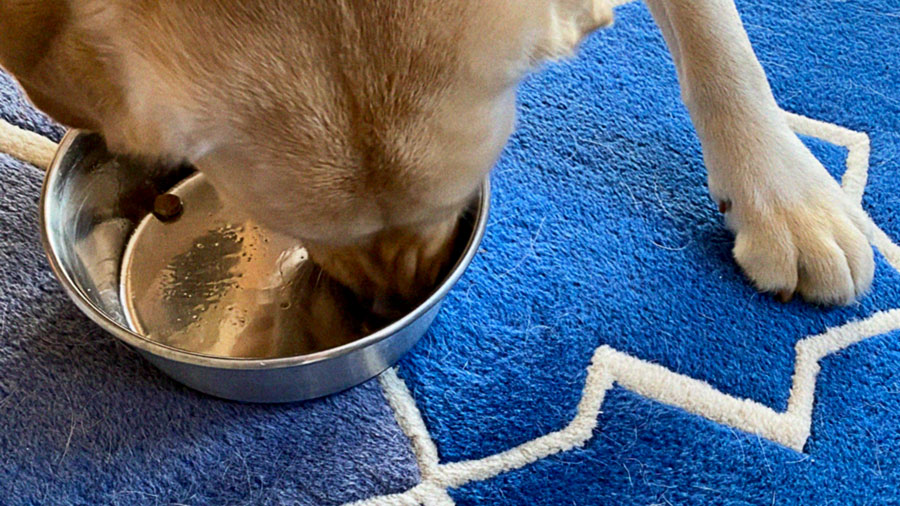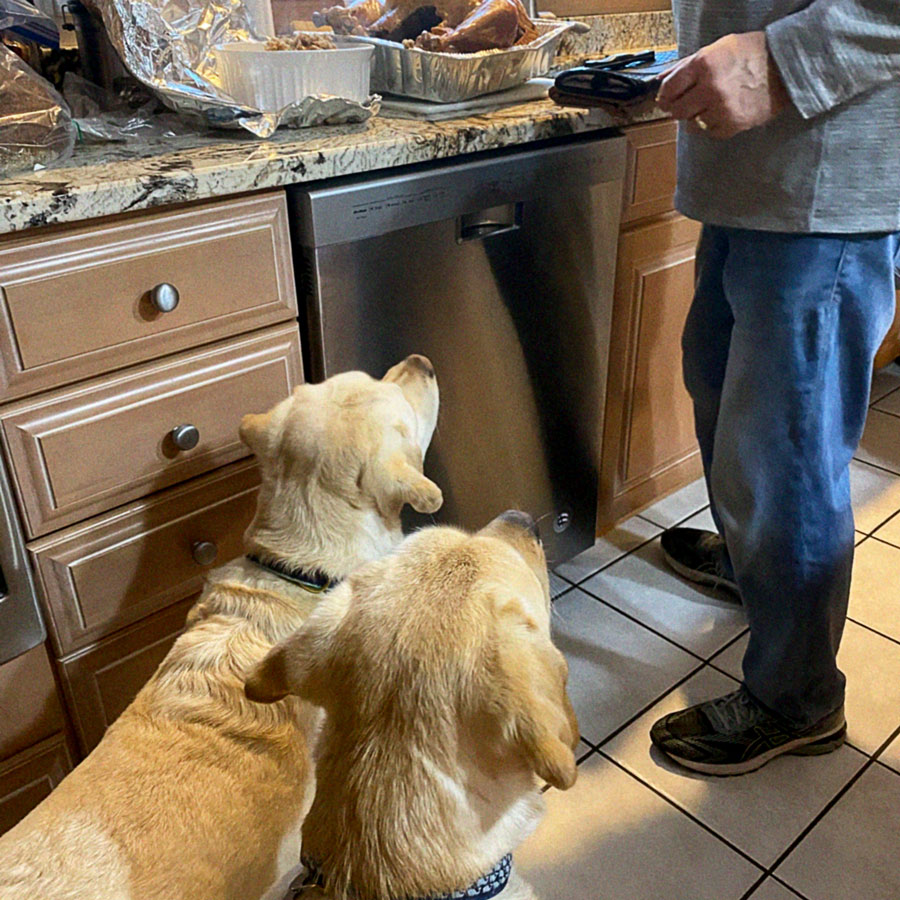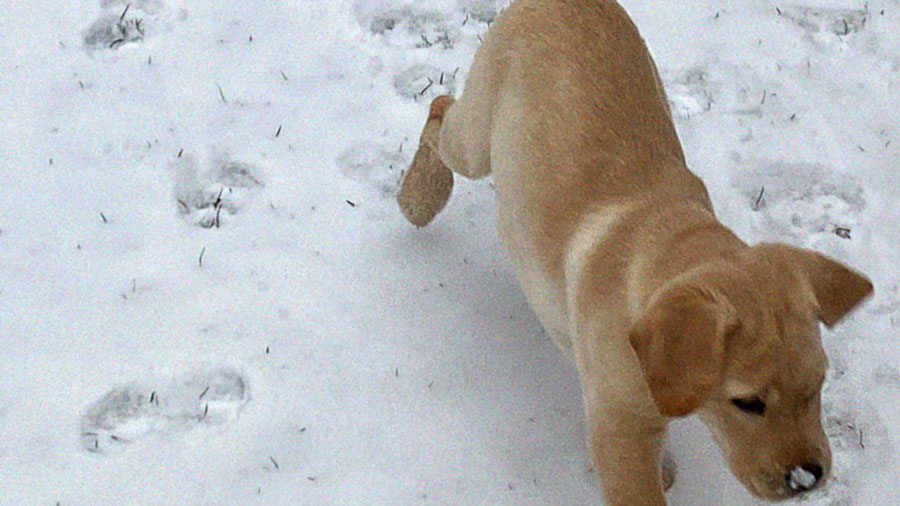When it comes to feeding your dog, if you’re anything like me, you’ll have been on a journey of discovery since they were a puppy (or since they entered your life) to find the perfect diet. And once you do, the rule is simple: find something and stick to it. There’s a lot of risk to switching things up, so for many, a lot of research (and trial and error) that needs to be done before perfect is found.
We have one older dog, a gorgeous labrador called Tegan, but this January, just before the pandemic hit, a new family member joined us, the puppy Murphy. Murphy came with lots of recommendations on what to feed him; from the breeder, the vet, family and friends (let’s just say, everyone’s got an opinion) and rather than go down the discovery rabbit hole again, we kept him on the food his breeder was using.
For the first couple of months, all was well, and then the pandemic hit. And with it came the unanticipated supply chain issues we’ve all experienced. While the rest of the world seemed to be scrambling for the next roll of toilet paper, we had a whole different set of scrambling to do, finding a new food for a maturing puppy who at 60 pounds had outgrown his puppy food, but the adult version was out of stock and with no ‘back on the shelves date’ in sight.
And so we were faced with a challenging situation, how to find a new food for Murphy, and the start of what became many hours of discussion in our attempt to figure out what to put in the empty bowl.
Any dog owner knows changing their pet’s food is fraught with challenges. The wrong choice can lead to tummy issues, some adventurous house or backyard clean-ups and even reveal some food allergies and sensitivities you didn’t even know existed (who knew so many dogs can’t tolerate chicken).

Faced with making this transition, I found it interesting that none of the pet food brands influenced my decision making. For someone who works in marketing and advertising it struck me as very odd that despite the readily available websites, showcasing portfolio, ingredient information and nutritional guidance, I didn’t once consider going to their websites to deep dive into what they could offer Murphy for dinner time. Once again I relied on suggestions and advice from the people around me as well as our vet.
When I mentioned this on a call with our team one day, I discovered I wasn’t the only one in this situation. Many of our team were facing similar issues with their dog’s diet being disrupted, many experiencing the same confusion and challenges in navigating their way to a next-best food.
As researchers, we couldn’t help ourselves, we had to see how other dog owners were meeting the challenge so we set ourselves our own ‘pet project’ and interviewed over 500 dog owners across the US, Canada and UK to explore how they were experiencing dog parenting in a pandemic and in particular, how they were handling any disruption to their dog’s diet. What we discovered is 75% had faced the decision making dilemma.

What did we find out?
Aside from loving their dogs, and spoiling them during the pandemic with treats, toys and belly-rubs, dog owners were experiencing two very different reactions to switching their pet’s food…
There were those who discovered the disruption once they went to the pet food or grocery store and were met with an empty shelf. On realizing their pet’s usual food wasn’t available they were forced into making a quick decision in-aisle. Whilst this opportunity to try new things appealed to some (and were fortunate their dogs responded to the new food with the bowls licked clean), for others this proved to be a big pain point for; standing faced with multiple brands, skews and options and the need to make a quick decision, most ended up entering into a cycle of trial and error, working their way through what was available until they found something that didn’t end up with them poop-scooping their bedroom floor at 3 am.
“Roxy has been really happy with it! We were nervous at first at how her stomach would react (because OMG there is some crazy stuff coming out of there), but everything was fine.”
“We just ran out and had no time to go to Pet Value, so I got him some brand at Loblaws. It was fine. He seems to like new flavours.”

And then there was a second group of dog parents who decided to embrace the extra time on their hands courtesy of lockdown and venture deep into the internet on a hunt for resources to help them make what they felt was the most informed decision possible. They explored home cooking, raw food, wet vs. dry food, and really leaned into what was best for their pets with the mindset of “what works for me, works for my pet.”
“I am interested in feeding a balanced fresh diet, tried some raw things, but I don’t have the money to make the food right now. I wanted a good kibble that wasn’t Purina, so I joined several scientifically driven interest groups to discover the best alternative brands. Brodie’s poops are small and solid, his coat and nails are healthier, and his body composition is more solid. I was excited about doing research and felt like I was a good provider in doing my research.”
“I changed to Farmers Dog as I started hearing more and more positive things about the healthier food for dogs. I also had Blue Buffalo and changed to Nulo because a friend shared a scary article with me about it being part of the heart disease study. I think I will stick with Nulo and Farmers Dog as Owen loves both and with Farmers Dog, you’re switching it up between Turkey, Pork and Beef so he is getting a nice variety! All types have also not affected his little tummy which is already a GREAT sign.”

No matter which reaction, one thing that was immediately clear and 100% consistent was all had their dogs best interests and tummies in mind!
We asked our fellow dog lovers for the key factors they considered when making a choice, whether in-aisle or at home, deep in the internet. Almost unanimously it came down to three things:
- Nutrition – Is this food nutritious and healthy for my dog? Is it what they should be eating? Is it species appropriate?
- Ingredients – What is actually in this food? And what isn’t? Does it contain anything that’s likely to trigger an allergy (hello chicken, again – who knew)
- Palatability – Does this actually look/smell like something they will eat? Will they enjoy it? Will I get to feel the relief of seeing a bowl licked clean?
And despite our sample including budget and premium dog parents, “Price” wasn’t a key consideration. All wanted to find the best food they could at their own price point. [Note: Our sample was skewed more towards the involved end of the dog owner spectrum / ‘dog parents’.]
What’s been interesting for me in doing this research, was seeing and hearing my experience with Murphy reflected back at me through the words of hundreds of strangers. We were all in the same boat. I wasn’t the only one without a clue how to make a decision about pet food in a moment of crisis.
Eventually, after my own cycle of trial and error (including some 3 am poop pick-ups), I struck gold. I found a winner for Murphy.
Aaaaand then who’s happy??? Both you guys!!!

So what does all this mean?
Switching up food is not easy. It’s not easy if you’re planning for it, preparing for it, but it certainly isn’t easy if it’s thrust upon you. You want to make the right choice but discovering what’s ‘right’ involves a whole lot of trial and potential error.
Unless you’re someone who makes a habit of reading up on all things doggy nutrition, finding helpful information, advice and recommendations in the moment is all but impossible. Your go-to resources default back to those when you first got your dog – family, friends, vet. And all of those come with their own biases and points of view. After all their dog isn’t your dog. Their dog’s tastes and idiosyncrasies aren’t your dogs.
And if you’re brave enough to head deep into the internet; overwhelm hits quickly. Finding your way through the endless blogs, articles, papers and journals is a task in itself, not to mention the headache of judging which ones you can trust.
Unless you’re thrilled at the prospect of playing Russian roulette with your pooch’s digestive system and taste buds, no matter which way you go, switching food is something best done with help and guidance from people who know what they’re talking about.
And even when you do take advice, do all your research, there’s still no guarantee of success.
“I tried switching to diet food. I did a heap of research, bought food that was specific to her breed, checked the ingredients list and googled what would be best for her. Unfortunately, she refused to eat it. I tried sticking to it for a couple days, but she wouldn’t budge. She’s a stubborn one.”
So, what this all means is there is a huge opportunity for dog food brands to really understand how their consumers are making decisions (particularly in crisis) and then find ways to really help them. To remove as much pain from the situation as possible.
One thing is for sure, there is a real need for pet food brands to give unbiased help and guidance on all things doggy nutrition (a resource not just portfolio promotion), to create ways of helping consumers navigate all the different decision elements to find options that minimize tummy disruption and maximize bowl licking.
From apps to advertising, we’ve been imagining all the different ways dog lovers’ lives could be less painful in these moments of ‘choice in a crisis’, and the opportunity for brands to make a positive difference to people like me and dogs like Murphy is immense.
We’re pretty sure it’s not a question of if, but when. And more importantly who.
With love from John & Murphy (& Tegan)


